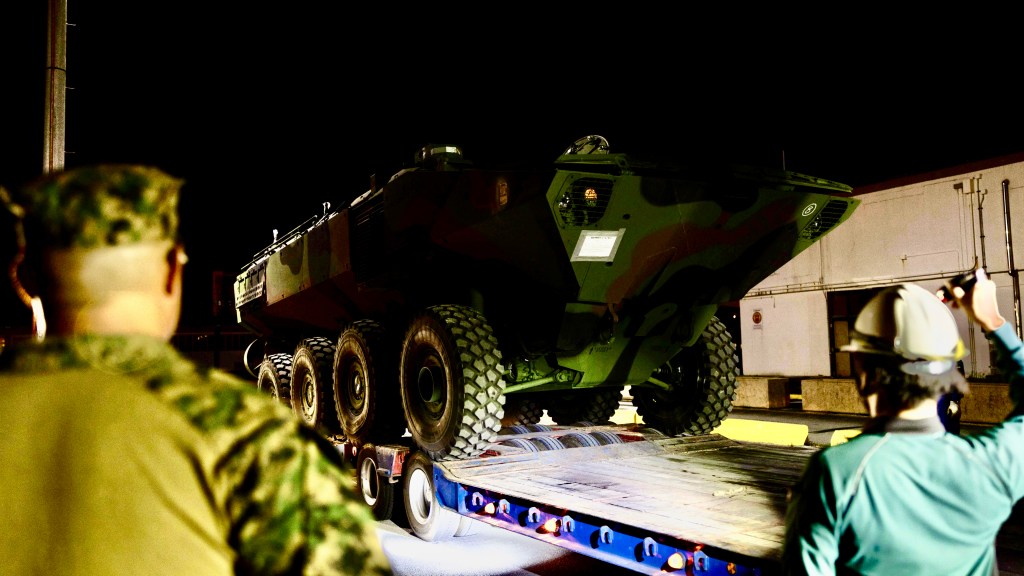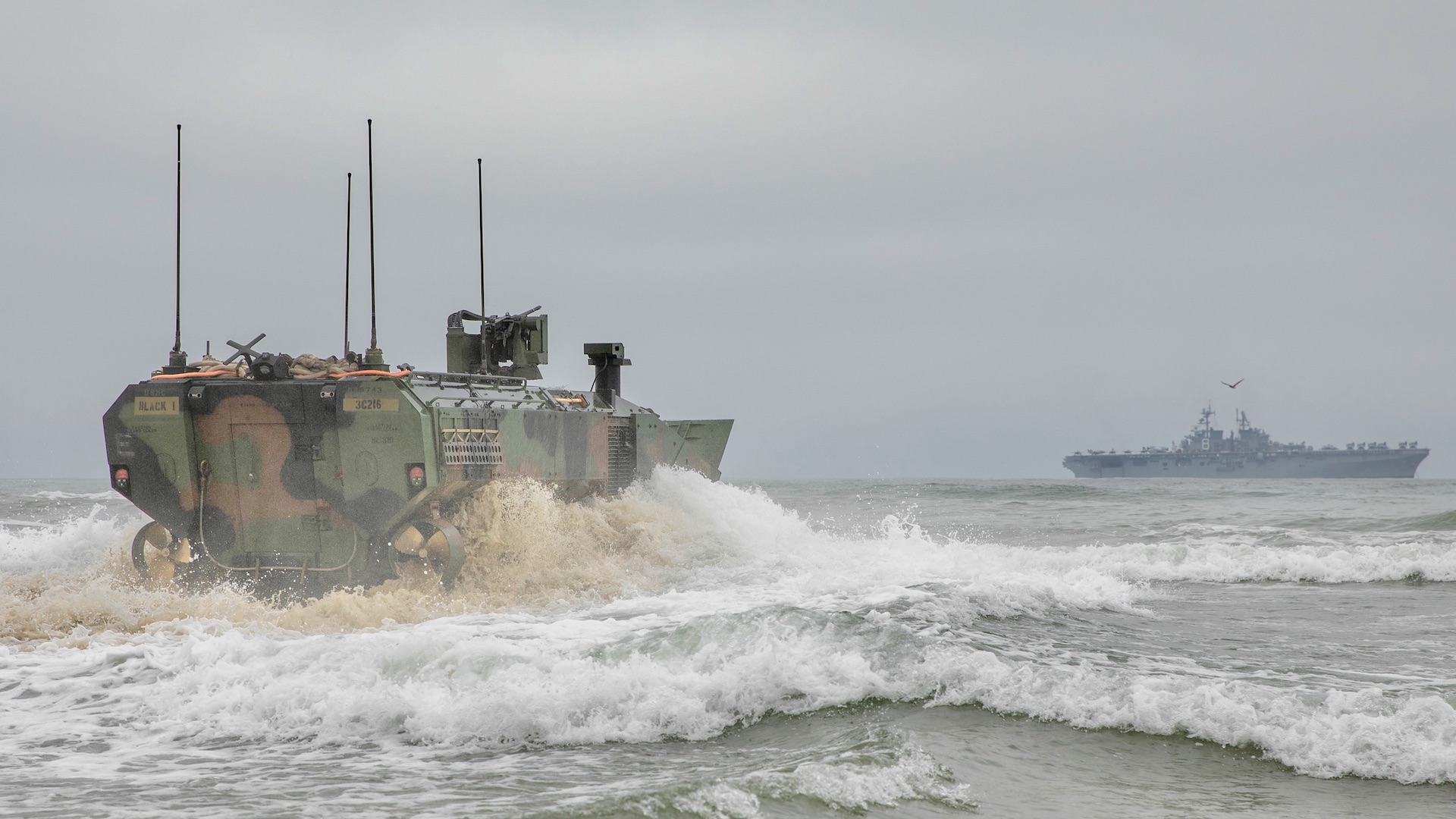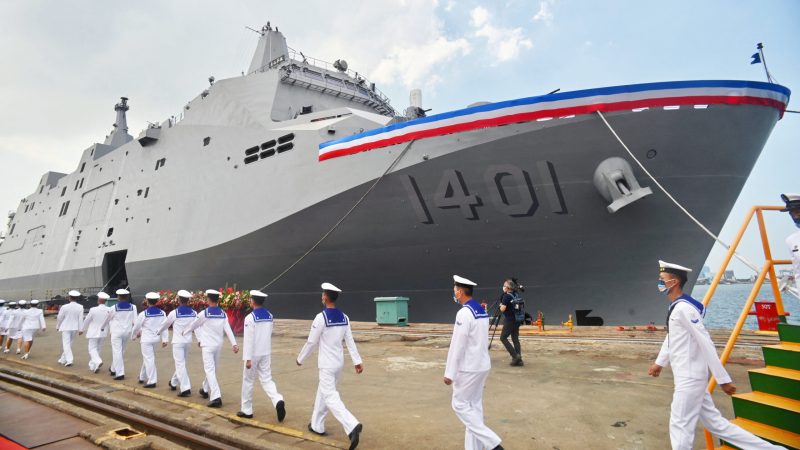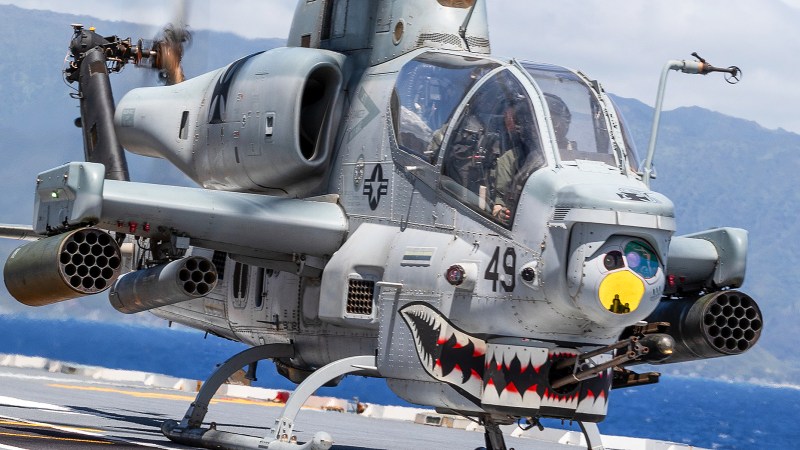A fleet of Marine Corps wheeled Amphibious Combat Vehicles (ACVs) is now forward deployed to the island of Okinawa, Japan, marking an important step in modernizing the service’s Pacific theater assets. Its arrival comes as the Marines are rapidly restructuring for the high-end fight of the future, with an emphasis on preparing for a potential island-hopping conflict in the Indo-Pacific involving China, where amphibious capabilities would be critical.
The shipment was received on June 29 at the Naha Military Port, Okinawa. The 4th Marine Regiment, III Marine Expeditionary Force based at Camp Schwab in Okinawa is set to receive a total of 12 ACV-Ps, the baseline personnel carrier of the Marines’ new ACV, this month according to Tim Hough, commanding officer and program manager Advanced Amphibious Assault (PM AAA). Those vehicles, which are manufactured by BAE Systems, are replacing the service’s aging tracked Assault Amphibious Vehicles (AAV).

“The arrival of the ACV [in Japan] realizes a long-projected update to the current armed ship-to-shore connection and ground combat capabilities of the AAV,” the service noted. Over the coming days, the vehicles will be transported from the Naha Military Port, southern Okinawa, to Camp Schwab further north, a roughly 50-mile journey by road.
The forward deployment of these modernized vehicles to Japan is particularly significant given the critical role they would play in a possible future conflict in the Indo-Pacific. This is an eventuality the service has been preparing for as a growing possibility for some time, and which some senior U.S. military officials believe could materialize within the next few years. Such a conflict would require Marines to rapidly deploy to remote islands, a challenging prospect logistically given the scale of a region dominated by water. Amphibious operations would be key in this instance, in which relatively small groups of Marines would need to establish themselves on various islands and rapidly reposition as necessary. This is beyond potentially much larger amphibious assaults that could occur during such a conflict.
“The ACV’s ability to use the ocean and waterways to carry Marines and equipment make it well-suited for a variety of operating environments,” notably within the Indo-Pacific, the service highlights.

“III Marine Expeditionary Force is a modern, ready force,” said U.S. Marine Corps Lt. Gen. Roger B. Turner, III MEF commanding general. “Upgrading our fleet with amphibious combat vehicles capable of supporting sea denial and maritime operations will further bolster our ability to support deterrence efforts and respond to contingencies in the Indo-Pacific.”
Able to transport up to 13 Marines, the ACV-P is one of several mission-role variants of the baseline ACV — the others being an ACV-C command and control type and an ACV-R recovery variant. The Marines will also receive an ACV-30 armed with a 30mm cannon. Its Mk 44 Stretch Bushmaster dual-fed cannon will in fact be the largest gun on a mechanized vehicle in the service’s inventory, following the divestment of Marine M1 Abrams tanks.

The ACV-P itself constitutes an important capability upgrade for the service over its existing AAVs, the first versions of which were introduced into service in the early 1970s. The legacy AAVs have themselves suffered a number of serious accidents in the recent past, most notably the deadly sinking of one during an exercise off the Californian island of San Clemente, resulting in the deaths of nine crew members.
The Marine Corps’ decision to replace a tracked vehicle with a wheeled design has been the subject of much debate. Wheeled vehicles have had mixed performance traditionally on softer terrain such as sandy beaches compared to hard surfaces. The ACV and AAV both move at about the same speed in the water, as well. On improved surfaces ashore, the ACV’s stated top speed is around 20 miles per hour faster than that of the AAV.
Unlike the flat-bottomed AAV, the ACV also notably has a v-shaped hull, reducing the risk to its occupants from mines and improvised explosive devices. The ACV features a more modern communications suite and other improvements. You can read more about the key differences between the two types in this past War Zone article.

It should be noted that the forward deployment of Marine Corps ACVs to Japan comes after the type arrived in the country for the first time last month. During training exercises on June 24, ACV-Ps with the 15th Marine Expeditionary Unit (MEU), a unit out of Camp Pendleton, California, took them ashore at the White Beach training area, Okinawa.

Intriguingly, one of the ACV-Ps pictured during that exercise bears the slogan “Make Peace Or Die” on its bow plane, which is designed to help it move around in the water. That particular vehicle looks to have been nicknamed “Cerberus,” which in Greek mythology refers to the multi-headed hound of Hades, a name that has also been used for other, higher-profile U.S. military assets.


Before that, the 15th MEU’s ACVs made their operational debut in the Pacific during Exercise Balikatan ’24, an annual bilateral exercise conducted between the Philippines and the U.S. There, ACVs conducted a live-fire, waterborne gunnery range exercise in Oyster Bay in the Philippines, on May 4.

The Marines are still in the process of receiving the different ACV variants from BAE Systems, which in cooperation with Italy’s Iveco, won the competition to build the vehicles for the service in 2018. As of May, the Corps has received a total of 184 ACV-Ps and three ACV-Cs, for a grand total of 187 vehicles.
It is expected that the Corps will eventually have a total of 390 ACV-Ps, 33 ACV-Cs, 34 ACV-Rs, and 175 ACV-30s, for a grand total of 632 vehicles. Production on the ACV-30 is expected to start in Fiscal Year 2025, with deliveries of the first six examples anticipated in Fiscal Year 2026. BAE Systems delivered the first production-ready ACV-C in January.

The ACV program has been working through certain technical and other issues since the first operational examples of the baseline personnel carrier version were delivered in 2020. That year, a report by the Defense Department’s top weapons tester noted survivability issues with the design, as well as cramped internal conditions for personnel.
Just last year, then-Marine Corps Commandant Gen. David Berger, highlighted problems with the vehicles’ shock absorbers and concerns over “possible water incursion.” A that time Berger still noted the ACV’s potential to “greatly enhance [the Marine Corps’] littoral mobility and expeditionary reach.”
Of course, this investment in technologically advanced ACVs is symptomatic of the wider restructuring of Marine capabilities of late; in which the service is moving away from counterinsurgency campaigns of the past to the sorts of distributed operations that would characterize the future of high-end conflict, such as in the Indo-Pacific. And while many of the service’s ACVs have yet to be delivered, the vehicle’s forward deployment to Japan represents an important stepping stone in preparing for that likelihood.
Contact the author: oliver@thewarzone.com
































